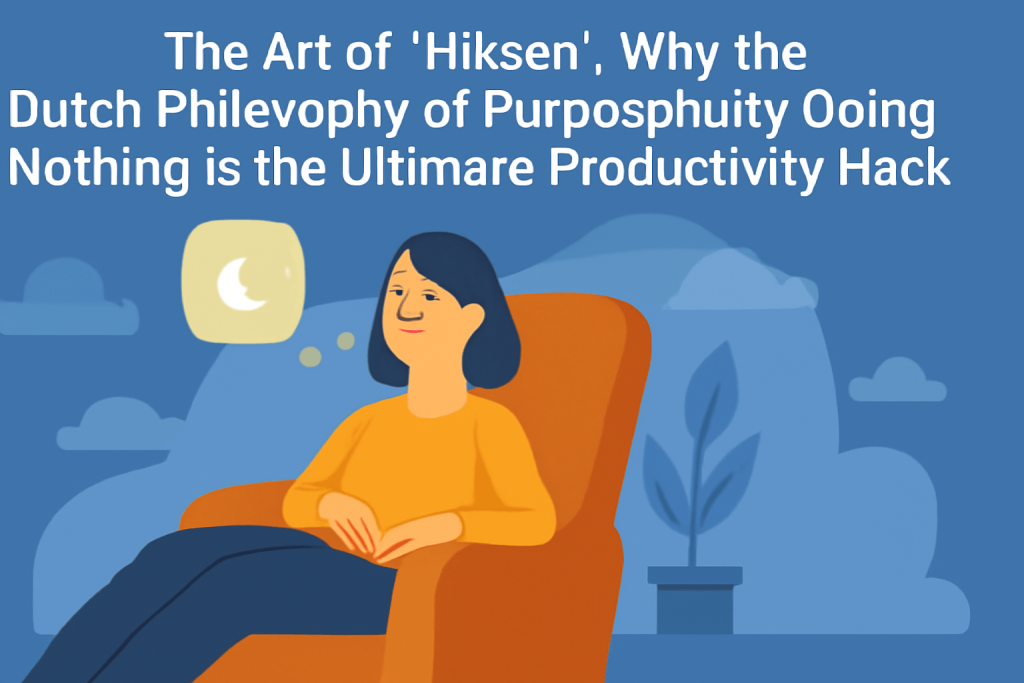Our modern world has a disease. A disease of “busy.” Every moment is scheduled, optimized, and filled. But in the Netherlands, they have a word for a radical cure: ‘Niksen.’ The art of purposefully doing nothing.

The Rebellion Against ‘Busy’: What is Niksen?
In a culture that worships at the altar of productivity, doing nothing sounds like a sin. But the Dutch concept of Niksen is not about laziness. It is a conscious, deliberate act. It’s the art of being idle without a purpose. Not scrolling through your phone. Not listening to a podcast. Not even trying to be mindful. It is simply letting your mind wander freely, like a cloud drifting across the sky. It’s looking out a window. It’s sitting on a bench with no agenda. It’s the polar opposite of “hustle culture.” Where our society sees an empty space in the calendar and feels an anxious urge to fill it, Niksen sees that empty space as a vital and necessary opportunity for the mind to simply be. It’s a rebellion against the idea that every second of our lives must be productive.
Niksen vs. Mindfulness: The Crucial Difference
It’s easy to confuse Niksen with mindfulness or meditation, but they are fundamentally different practices. In fact, they are almost opposites. The goal of mindfulness is to train the focus. It’s the practice of gently bringing your attention back to a single point, like your breath or a physical sensation, over and over again. The goal of Niksen is to release the focus. It’s about letting go of the reins completely. Modern life offers a spectrum of engagement, from the deep focus of meditation to the high-stimulation, rapid-decision environment of a digital entertainment platform. One can see an example of such a fast-paced, interactive system here. Niksen, however, occupies the other end of that spectrum. It is a deliberate choice to step away from all such goal-oriented activities. It’s the practice of allowing the mind to be truly at rest, without a task to complete or a game to win.
The Science of the Wandering Mind: Activating Your ‘Default Mode Network’
This isn’t just a quaint cultural idea; there’s powerful neuroscience behind it. When our brain is not actively focused on a goal-oriented task, a specific network of brain regions called the “Default Mode Network” (DMN) lights up. For a long time, scientists thought this was just the brain’s “idle” state. But they now know that the DMN is incredibly important. This is the network that is active when we are daydreaming, reminiscing about the past, or thinking about the future. It’s the part of the brain that makes new and creative connections between disparate ideas. It’s the engine of our creativity and our problem-solving ability. Those sudden “aha!” moments or brilliant ideas that seem to pop into your head in the shower? That’s your Default Mode Network at work. Practicing Niksen is a way to deliberately create the conditions for this network to activate.
How to Do Nothing: A Practical Guide to Practicing Niksen
The irony of Niksen is that in our over-stimulated world, we actually have to practice how to do nothing. It can feel uncomfortable at first. But the key is to be gentle and to have no expectations. Here are a few simple ways to start:
- The Window Gaze: Simply sit by a window for five to ten minutes and watch the world go by. Don’t try to analyze anything. Just watch.
- The Bench Sit: Find a park bench or a comfortable chair. Sit down. And just sit. Without your phone. Without a book.
- Music Without Meaning: Put on some instrumental music, preferably something you don’t know. Let it be pure background sound, without trying to listen to it actively.
The goal is to let your mind be free. If it wants to think about your grocery list, let it. If it wants to re-live a memory, let it. The only rule is that there is no goal.
The Benefits of Being ‘Idle’: From Reduced Burnout to a Creativity Boost
The paradox of dedicating time to do nothing every now and then is that you become more efficient at doing something. Niksen has its benefits which are documented. It allows us to avoid the burnout and anxiety in our brains that we experience on a daily basis when we are required to devote our complete focus to whatever it is that we are doing. It enables the mind to process the information and lay down memories in the background which can enhance learning. And above all it gives the mind the room to become creative. Due to our preoccupation on an issue, our minds may become rigid and form clogs. It is when we make that step back and allow our mind some breathing space that we then can make the new and unexpected associations on which a creative breakthrough will be based. It is the fallow period that causes the field of the mind to be fertile again.
Conclusion: Reclaiming the Lost Art of Doing Nothing
We have lost the value of idleness as we are always in the endeavor to do something. We have jammed every free corner with notifications, podcasts and the feeling that we should do something productive. Niksen is the much needed and effective antidote to this modern madness. It is an eye-opener that our brains, like our bodies, will need a bit of real, disorganized downtime so that they can do their best work. It makes us realize that we will strive to find some of our best ideas and deepest insights at a time when we have ceased to seek them. It is not the time wasting. It is a matter of finding again a great and very human thing of our experience, the art of doing nothing at all, the simple, beautiful, and surprisingly fruitful art of doing nothing at all.